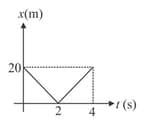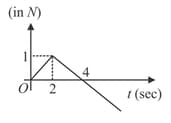The position-time graph of a particle of mass moving along -axis is as shown in the figure. The magnitude of impulse on the particle at is



Important Questions on Laws of Motion
A slab rests on a frictionless floor. A block rests on top of the slab. The coefficient of friction between the block and the slab is The block is acted upon by a horizontal force of If the resulting acceleration of the slab will be

A block of mass is kept on a wedge of mass as shown in figure such that mass remains stationary wedge. The magnitude of force is

Force acting on a body varies with time as shown below. If initial momentum of the body is then the time taken by the body to retain its momentum again is

In the figure shown, horizontal force is applied on a block but the block does not slide. Then as the magnitude of vertical force is increased from zero the block begins to slide; the correct statement is

